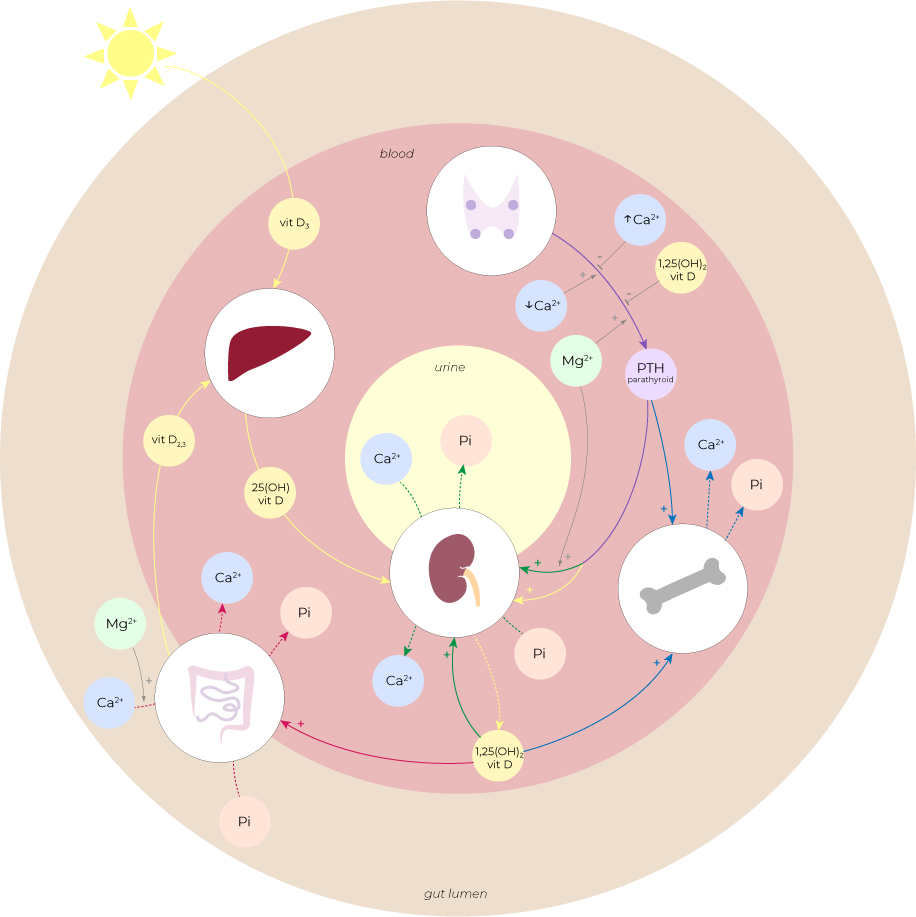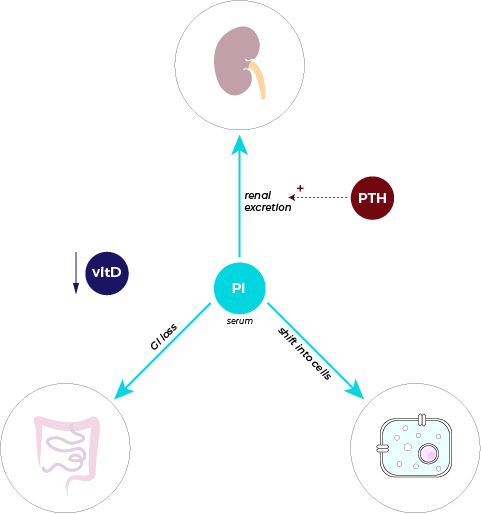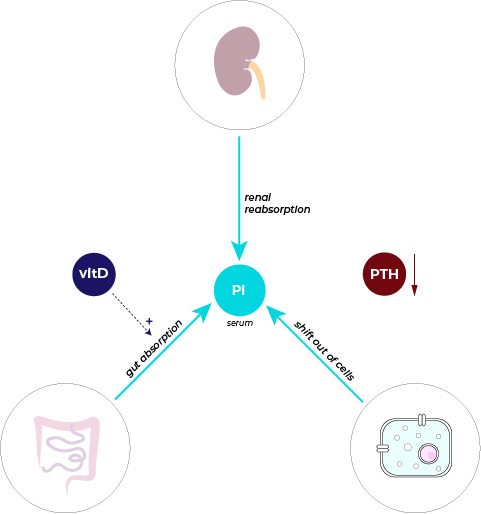• Inorganic phosphorous (Pi) compounds (mainly in the forms of PO43-, HPO42-, H2PO4-) move between the blood vessels and 4 different body compartments:
Renal tubule: via renal reabsorption and excretion mechanisms
Bone: via bone deposition and resorption
Gut lumen: via absorption and secretion across GI cells
Intracellular space: via movement across ion channels
• Pi imbalance arise when their movements between these body compartments are disregulated.
• Some of the regulators of Pi are parathyroid hormone (PTH) and vitamin D:
PTH: via renal reabsorption and excretion mechanisms
Vitamin D: via absorption and secretion across GI cells

PTH stimulates calcium cations (Ca++) and phosphorous (Pi) release from bone breakdown, Ca++ reabsorption (but Pi excretion) from renal tubules. PTH stimulates renal conversion of 25(OH) vitamin D to 1,25(OH)2 vitamin D, which then further stimulates bone breakdown, Ca++ reabsorption/ Pi excretion from renal tubules, in addition to enhancing gut absorption of Ca++ and Pi. 25(OH) vitamin D is the product of liver metabolism of vitamin D that enter the body from the gut and sunlight. PTH secretion from the parathyroid gland is triggered by low serum Ca and high serum magnesium levels, and is suppressed by high serum Ca and vitamin D levels.
hypophosphatemia

3 main causes of hypophosphatemia:
• renal excretion,
• GI loss, and
• intracellular shift
mediated by high PTH, low vitamin D level
hyperphosphatemia

3 main causes of hyperphosphatemia:
• renal reabsorption,
• gut absorption, and
• extracellular shift
mediated by low PTH, high vitamin D level
✿ Increased renal excretion
✧ hyperparathyroidism
✧ renal replacement therapy
✧ fanconi syndrome
✧ primary renal phosphate wasting
✧ metabolic acidosis
✧ drugs
⁎ acetazolamide
⁎ iv iron
⁎ chemotherapy
✿ GI loss
✧ low intake/ malnutrition
✧ drugs
⁎ antacids
⁎ niacin
⁎ phos binder
✧ secretory diarrhea
✧ malabsorption/ steatorrhea
✧ vitamin d deficiency or resistance
✿ Shift into cells
✧ refeeding syndrome
✧ respiratory alkalosis
✧ recovery from diabetic ketoacidosis
✧ insulin therapy
✧ hungry bone syndrome
✿ Other
✧ hypomagnesemia
✿ Decreased renal excretion
✧ renal insufficiency
✧ hypoparathyroidism
✧ familial tumoral calcinosis
✧ acromegaly
✧ drugs
⁎ bisphoponates
⁎ cinacalcet
✿ Increased gut absorption
✧ vitamin d intoxication
✧ drugs
⁎ laxatives
⁎ fosphenytoin
✿ Shift out of cells
✧ tumor lysis syndrome
✧ hemolysis
✧ rhabdomyolysis
✧ metabolic acidosis
✧ malignant hyperthermia
✿ Pseudohyperphosphatemia
✧ paraproteinemia
✧ hyperbilirubinemia
✧ hyperlipidemia
✧ hemolysis
✧ drugs
⁎ heparin
⁎ tissue plasminogen activator (tpa)